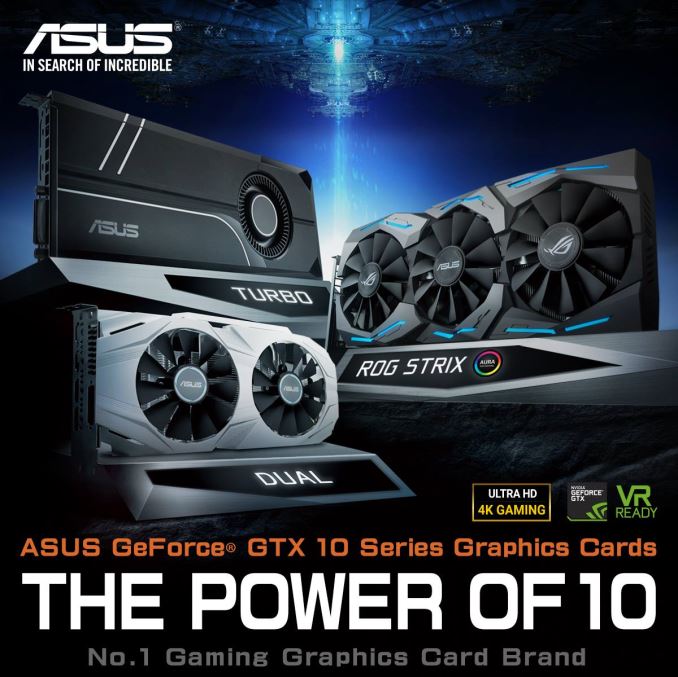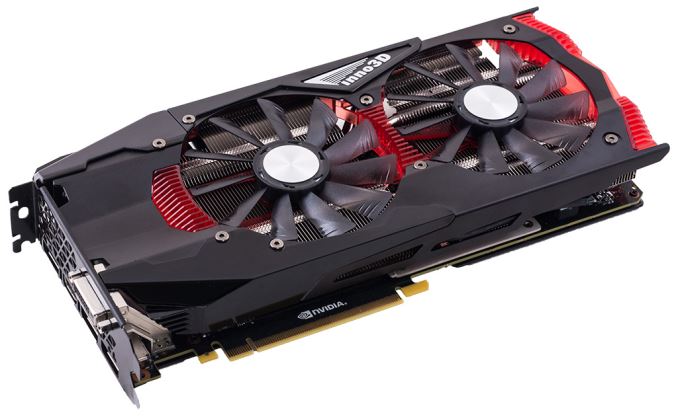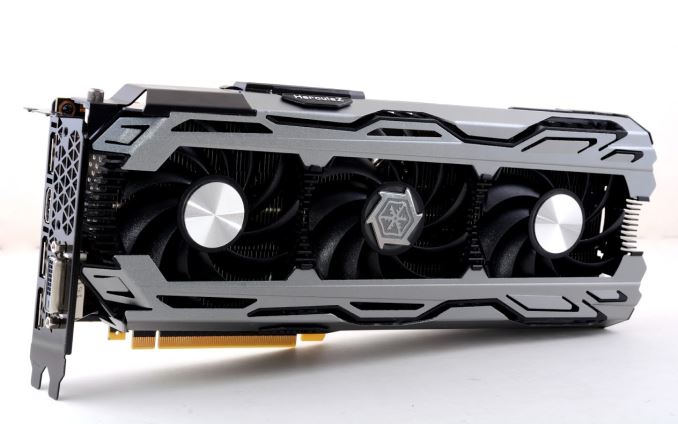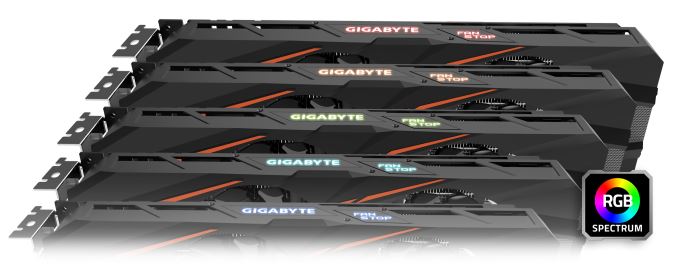ASUS, Inno3D, & Gigabyte Tease Custom GeForce GTX 1060 Cards
by Daniel Williams on July 8, 2016 9:00 AM EST
Yesterday we saw the announcement of NVIDIA's GeForce GTX 1060. Though NVIDIA is producing a reference Founders Edition card, as this is a more mainstream product, NVIDIA is leaving retail card production to their partners, who will be launching their custom solutions on day one. With the retail release still approaching what we have is more of a teaser then an announcement, but can begin to show us more of what the $250-$300 price bracket will start to look like as the GTX 1060 launch approaches.
ASUS has teased three separate renditions of the GeForce GTX 1060, as pictured above. These include a Turbo card with a blower, the Dual with two fans, and an ROG STRIX card. The last of which has the same cooler as the ROG STRIX 1080 and 1070, and as hinted by the AURA logo may feature the same RGB lighting found in the GTX 1080 and GTX 1070 ROG STRIX cards. There is no news yet on specs or performance numbers, or price and release date for these cards, but we should see those as soon as the July 19 release of the GTX 1060.
Inno3D has announced that two cards are on the way. First is the Inno3D GeForce GTX 1060 Gaming OC X2, which features two fans and translucent highlights. We don’t yet know of any physical details aside from what is pictured. Next we have the Inno3D GeForce GTX 1060 iChill X3. This card appears to be longer and also has three fans. While this cooler may be more effective than the two fan Gaming OC X2 card, it appears that these cards have identical specifications with a boost clock of 1784 and memory clock of 8.2Gbps. That identifies these cards with a factory overclock, but performance should be identical with the numbers that are currently reported.
Finally, in the truest definition of a teaser by not even showing the whole card, Gigabyte is teasing its GTX 1060 G1 GAMING. The card features a dual fan Windforce X2 cooler, with RGB lighting built into the shroud. Gigabyte has also disclosed that the card will feature a 6+1 phase power design (as opposed to 3+1), which indicates that they'll be using a custom PCB for their card and not NVIDIA's reference PCB.
Mainstream NVIDIA card launches typically feature semi and fully-custom designs from NVIDIA's partners right off the bat, so no doubt we'll see more custom cards unveiled as we get closer to the 19th. Meanwhile with vendors no doubt eager to lock in sales with premium cards, it remains to be see how many of these designs will actually approach the $249 MSRP NVIDIA has announced.
Sources:













55 Comments
View All Comments
HideOut - Friday, July 8, 2016 - link
Its about maximizing your overclock headroom, and quieter operation. Larger more effective fans and HS can turn slower and are typically quieter because of that, while having the capability of speeding up if need be for a max OC.eddman - Friday, July 8, 2016 - link
I remember years ago one of my friend's relatives bought an 8600 GTS with a MASSIVE cooler, thinking it's going to perform brilliantly, not knowing that it had just a quarter of the shaders found on 8800 GTX.(That card was the reason I abandoned my "buy mid-range" practice for that generation and go for the more expensive 8800 GTS 320MB, which turned out to be the better choice in the long run.
I remember being a bit mad and quite disappointed with NVidia's decision in midrange. Fortunately they came back to their senses with 9600 GT and never repeated that quarter-shaders travesty ever again.)
One of the advantages of bigger coolers is that they usually run much quieter. I personally prefer smaller cards, but if I can't get a quiet one, I'd buy a bigger version.
I'm looking forward to smaller 1060 cards.
Geranium - Friday, July 8, 2016 - link
No, NVIDIA cards are very efficient, thats why they need three fans or CLC to stay cool.nunya112 - Friday, July 8, 2016 - link
dont forget. when you shrinking the die. it becomes a mini nuclear reactor in there.the smaller things get. the harder it is to get rid of heat.
Samus - Saturday, July 9, 2016 - link
generally the voltage requirements scale down as well with a node shrink. The problem you are describing becomes an issue when the voltage doesn't scale down, i.e., boost clock/overclocking.Nvidias vapor chamber was really good at combating this but is kind of a solution looking for a problem these days. Even though the process node has shrunk, and transistor count has gone up, die area has stayed mostly the same so cooling hasn't become a huge challenge, you are still removing the same amount of heat from the same surface area.
sharath.naik - Friday, July 8, 2016 - link
I was expecting at least one mini-ITX length design. Especially since gigabyte released one for 1070. I was surprised by this missed opportunity.Samus - Saturday, July 9, 2016 - link
I suspect evga is going to introduce a badass single slot 1060, and at some point someone might introduce a passive cooled card. Asus did a DirectCU Radeon 7750 (80w?) awhile back that had a pretty beefy dual slot heat pipe on it, wouldn't be too hard to make a larger version cover 120w!chrcoluk - Sunday, July 17, 2016 - link
not really, the FE cards are under cooled as evident by their temp throttling issues.Whilst my 2.5 slot palit 1070 maxes out at 62C.
Stochastic - Friday, July 8, 2016 - link
"it remains to be see how many of these designs will actually approach the $249 MSRP NVIDIA has announced.Stochastic - Friday, July 8, 2016 - link
This is the critical question for me. At $250 an overclocked 1060 is a great value. For $280+? Not so much.